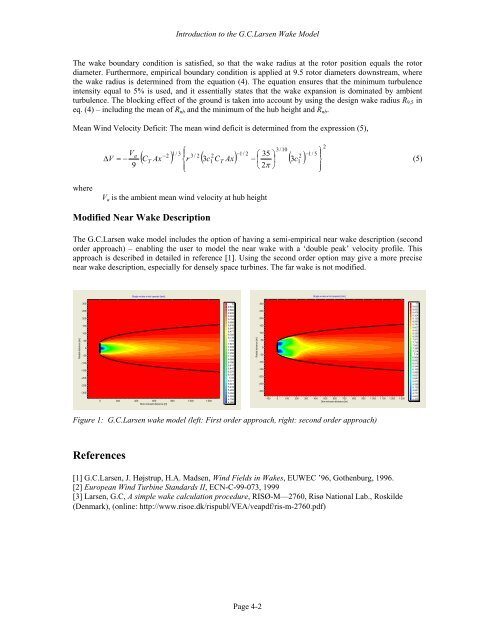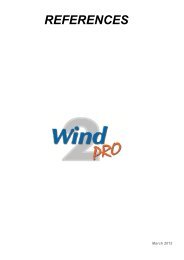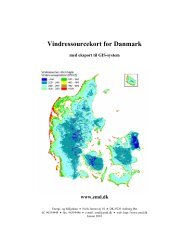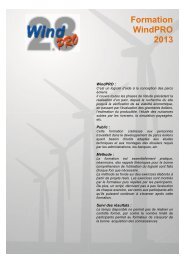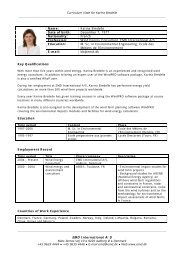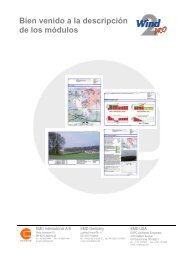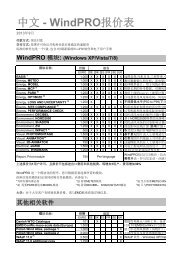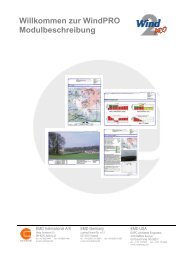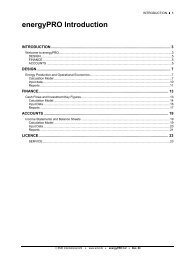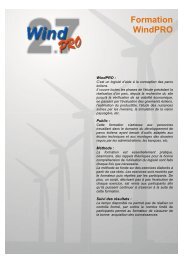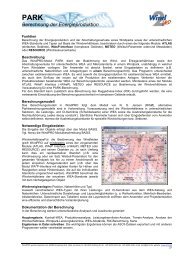WindPRO / PARK - EMD International AS.
WindPRO / PARK - EMD International AS.
WindPRO / PARK - EMD International AS.
Create successful ePaper yourself
Turn your PDF publications into a flip-book with our unique Google optimized e-Paper software.
Introduction to the G.C.Larsen Wake Model<br />
The wake boundary condition is satisfied, so that the wake radius at the rotor position equals the rotor<br />
diameter. Furthermore, empirical boundary condition is applied at 9.5 rotor diameters downstream, where<br />
the wake radius is determined from the equation (4). The equation ensures that the minimum turbulence<br />
intensity equal to 5% is used, and it essentially states that the wake expansion is dominated by ambient<br />
turbulence. The blocking effect of the ground is taken into account by using the design wake radius R 9,5 in<br />
eq. (4) – including the mean of R nb and the minimum of the hub height and R nb .<br />
Mean Wind Velocity Deficit: The mean wind deficit is determined from the expression (5),<br />
∆V<br />
V<br />
= −<br />
2<br />
3 /10<br />
2<br />
( ) 1/ 3 ⎪⎧<br />
3 / 2 2<br />
2<br />
2 1/ 5<br />
( ) 1/ 35<br />
⎪⎫<br />
a −<br />
− ⎛ ⎞<br />
−<br />
CT<br />
Ax ⎨r<br />
3c<br />
( )<br />
1 CT<br />
Ax − ⎜ ⎟ 3c<br />
9 2<br />
1 ⎬<br />
⎪ ⎭<br />
⎪⎩<br />
⎝ π ⎠<br />
(5)<br />
where<br />
V a is the ambient mean wind velocity at hub height<br />
Modified Near Wake Description<br />
The G.C.Larsen wake model includes the option of having a semi-empirical near wake description (second<br />
order approach) – enabling the user to model the near wake with a ‘double peak’ velocity profile. This<br />
approach is described in detailed in reference [1]. Using the second order option may give a more precise<br />
near wake description, especially for densely space turbines. The far wake is not modified.<br />
Single w ake w ind speeds [m/s]<br />
Single w ake w ind speeds [m/s]<br />
Radial distance [m]<br />
300<br />
250<br />
200<br />
150<br />
100<br />
50<br />
0<br />
-50<br />
-100<br />
-150<br />
-200<br />
-250<br />
-300<br />
0<br />
200<br />
400<br />
600<br />
Dow nstream distance [m]<br />
800<br />
1 000<br />
1 200<br />
10<br />
9.831<br />
9.662<br />
9.492<br />
9.323<br />
9.154<br />
8.985<br />
8.816<br />
8.647<br />
8.477<br />
8.308<br />
8.139<br />
7.97<br />
7.801<br />
7.632<br />
7.462<br />
7.293<br />
7.124<br />
6.955<br />
6.786<br />
6.617<br />
6.447<br />
6.278<br />
6.109<br />
5.94<br />
5.771<br />
5.601<br />
5.432<br />
5.263<br />
5.094<br />
4.925<br />
4.756<br />
4.586<br />
Radial distance [m]<br />
300<br />
250<br />
200<br />
150<br />
100<br />
50<br />
0<br />
-50<br />
-100<br />
-150<br />
-200<br />
-250<br />
-300<br />
-100<br />
0<br />
100<br />
200<br />
300<br />
400<br />
500 600 700<br />
Dow nstream distance [m]<br />
800<br />
900<br />
1 000<br />
1 100<br />
1 200<br />
1 300<br />
10<br />
9.826<br />
9.652<br />
9.478<br />
9.304<br />
9.129<br />
8.955<br />
8.781<br />
8.607<br />
8.433<br />
8.259<br />
8.085<br />
7.911<br />
7.736<br />
7.562<br />
7.388<br />
7.214<br />
7.04<br />
6.866<br />
6.692<br />
6.518<br />
6.344<br />
6.169<br />
5.995<br />
5.821<br />
5.647<br />
5.473<br />
5.299<br />
5.125<br />
4.951<br />
4.777<br />
4.602<br />
4.428<br />
Figure 1: G.C.Larsen wake model (left: First order approach, right: second order approach)<br />
References<br />
[1] G.C.Larsen, J. Højstrup, H.A. Madsen, Wind Fields in Wakes, EUWEC ’96, Gothenburg, 1996.<br />
[2] European Wind Turbine Standards II, ECN-C-99-073, 1999<br />
[3] Larsen, G.C, A simple wake calculation procedure, RISØ-M—2760, Risø National Lab., Roskilde<br />
(Denmark), (online: http://www.risoe.dk/rispubl/VEA/veapdf/ris-m-2760.pdf)<br />
Page 4-2


